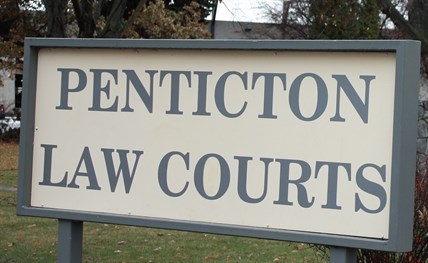
Counsel for both sides in the John Koopmans murder trial presented their closing arguments to the jury in Penticton court today.
(STEVE ARSTAD / iNFOnews.ca)
April 07, 2015 - 6:02 PM
PENTICTON - The lawyer for John Koopmans attacked the credibility of key Crown witnesses—including one of the complainants—telling jurors they can’t be believed.
Don Skogstad got his chance in Penticton Supreme Court today, April 7, to make some sense of six weeks of evidence the 12-member jury heard in the double murder trial.
John Ike Koopmans, 51, is accused of the first degree murders of Keith Wharton and Rose Fox on a rural property near Princeton in March, 2013, as well as the attempted murder of Bradley Martin. The bodies of the victims were discovered on a property on Old Hedley Road adjacent the Weyerhaeuser mill near Princeton in early March, 2013.
Skogstad challenged the testimony of key witness Steven Corlett-Parolin, calling him “completely devoid of credibility.”
“Corlett-Parolin makes up things he doesn’t really experience. What he says is absolute and complete fabrication,” Skogstad said. He described Corlett-Parolin as a “wanna-be cop” who changed the facts to suit the situation when describing Koopmans' gun ownership.
“Corlett-Parolin cannot be believed,” he said.
He told jurors to recall Bradley Martin’s evidence and how he described being forced to answer questions about his height and weight prior to being treated by ambulance personnel. He reminded jurors that police and emergency personnel on scene at the time gave conflicting accounts of that exchange.
“You heard the way Bradley Martin answered questions,” Skogstad said. “You’re not going to believe that.”
Skogstad also contested physical evidence found at the crime scene, including the blood spatters on Koopmans’ clothing. He said the tiny blood spatters could not have travelled more than 48 inches, which would have been short of where evidence said Koopmans stood during the shooting,
“It doesn’t add up. The spatters can’t get there. It does not fit - it does not fit,” he said.
Skogstad also noted blood spatter evidence of Martin’s departure from the residence lacked “directionality,” at odds with Martin’s testimony that he left the scene quickly.
Skogstad also pointed to holes in Crown’s motive theory. The Crown said Koopmans was angry at Wharton and Fox because he believed they were involved in a break in at his place. But Skogstad said Koopmans and Wharton patched their differences prior to the shooting.The break and enter on Koopmans property was attributed to three others, and most of the stolen articles recovered.
Skogstad cited witness testimony that described Koopmans as quiet, soft spoken and slow to anger.
“Six weeks after the break and enter he was so angry he did this?" Skogstad said before asking why, then, he would shoot Martin and let him escape the scene.
“No one pursued Martin. His was a non-lethal shot. The others were like a pro hit, yet no one pursued him,” he said, adding Koopmans could have planned the attack to take place when he knew Martin wouldn’t be there.
Crown Prosecutor Frank Dubenski pointed out inconsistencies in John Koopmans’ testimony during his remarks.
Dubenski described three alibi letters submitted by Koopmans, describing his actions the night of the murders. The letters dated back to August 6, 2014, more than a year after the incident, and described Koopmans leaving an East Princeton residence to walk to a friend’s some distance away on Old Hedley Road for an overnight visit.
Dubenski noted the alibi letter was inconsistent with Koopmans’ own testimony, in which he said his original intention was to visit Keith Wharton’s, to play cards and socialize.
Dubenski pointed to evidence of Koopmans’ deliberate actions in the murders, noting his unusual travel by foot the night of the murders, the unannounced visit at Wharton’s, the concealment of a weapon, and the fact he waited until all three victims were in the same room as evidence of premeditation.
He asked the jury to consider all the evidence together, including the weighing of circumstantial evidence.
“In some respects, circumstantial evidence is more appropriate to consider than the testimony of someone who may have a reason to lie,” he said. “You might doubt that it’s first degree or second degree murder, but that’s all the doubt you should have.”
Dubenski also asked the jury to consider the circumstances which Martin was testifying to, saying the minor discrepancies heard in his testimony were understandable.
“He has an obvious background of some difficulties. The basic story of Martin is corroborated. He made the identification when he should have,” Dubenski said, telling jurors they could accept some, part or none of a witness’s testimony.
Dubenski said Steven Corlett-Parolin’s testimony was largely corroborated by Koopmans.
“We heard how he was befriended by Koopmans. The vast majority of what he told you is supported,” he said.
Koopmans’ credibility also came under scrutiny by Dubenski, who noted Koopmans received a disability pension while working and was willing to deceive a mining company as well as buy drugs for Keith Wharton.
“If you look at the scales of justice, and consider the evidence you have heard in this trial, you’ll see the scales starting to weigh heavily against the accused, to the point where you should have no reasonable doubt,” said Dubenski.
It is anticipated Judge Marion Maisonville will charge the jury tomorrow.
For more strories on the John Koopmans murder trial, click here.
To contact the reporter for this story, email Steve Arstad at sarstad@infonews.ca or call 250-488-3065. To contact the editor, email mjones@infonews.ca or call 250-718-2724.
News from © iNFOnews, 2015